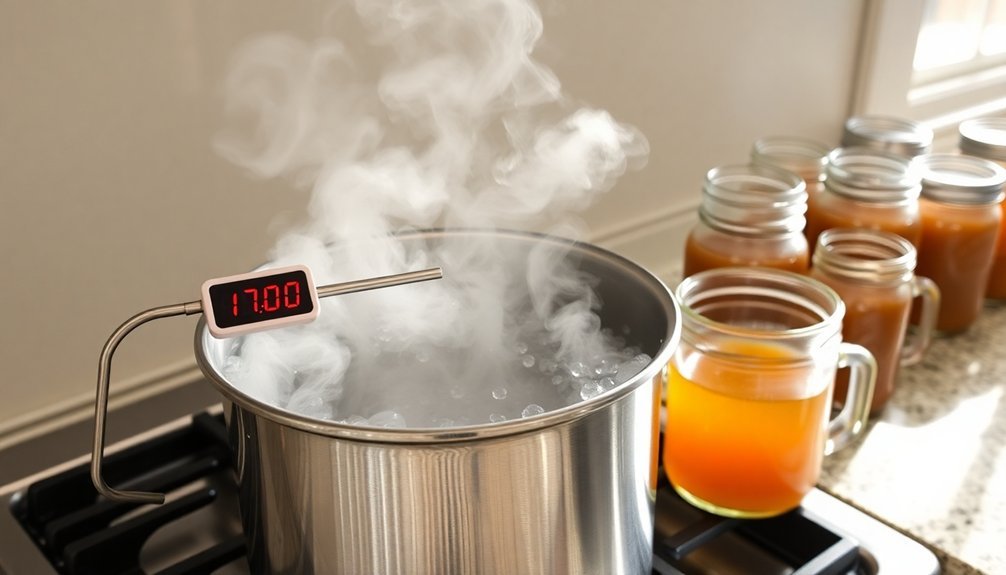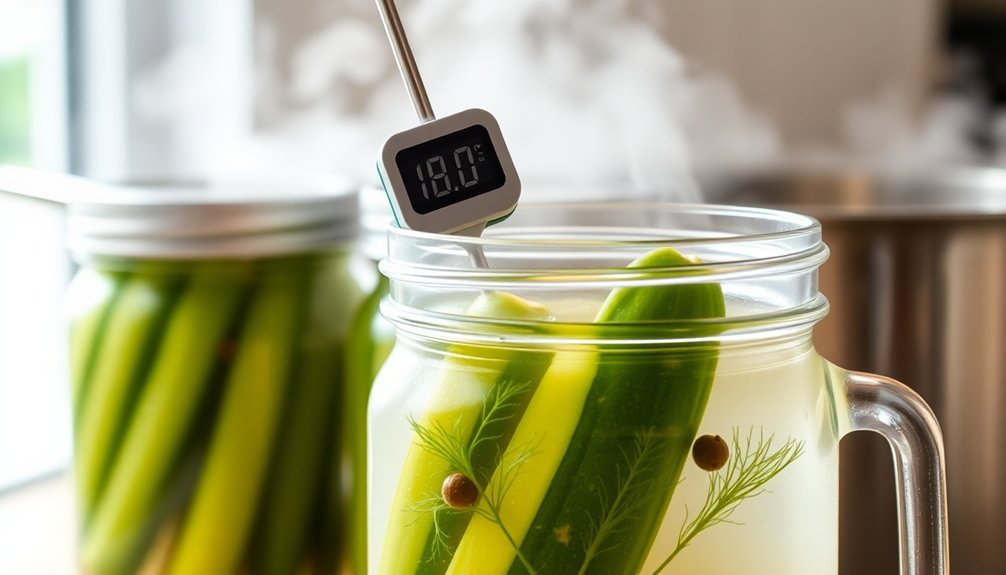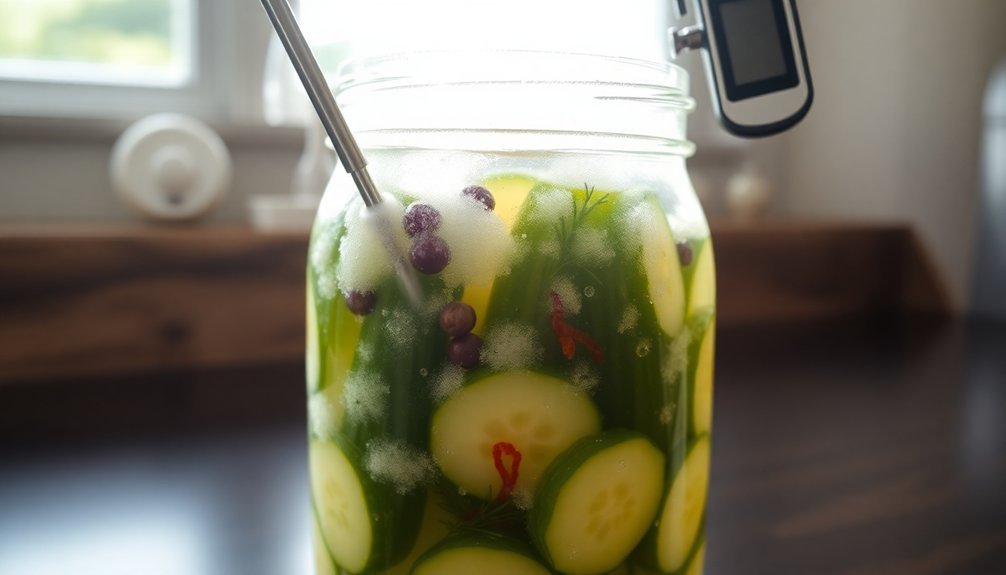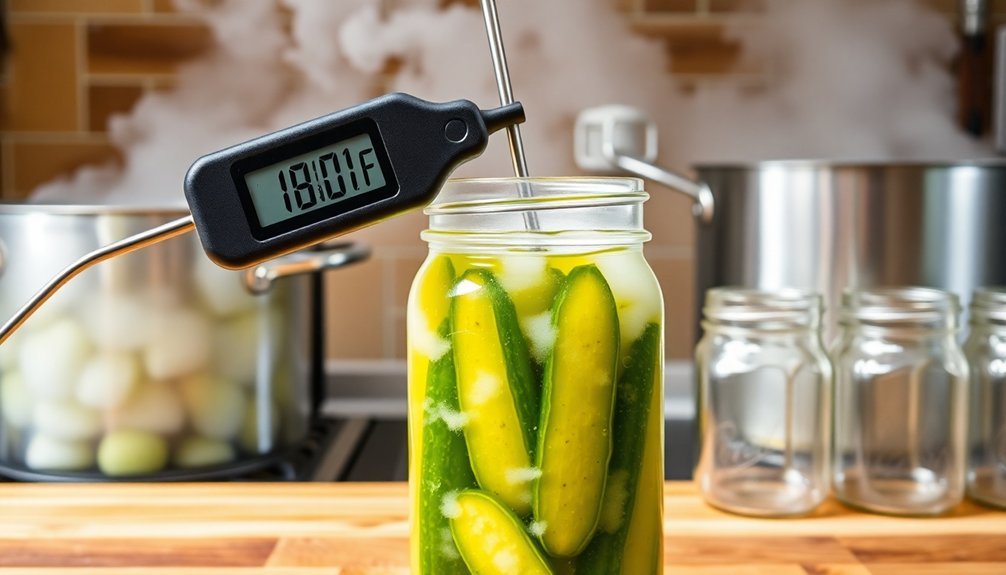To safely pickle foods, you'll need to maintain precise brine temperatures between 165°F and 180°F when filling jars. Start by heating your water bath canner to 140°F for raw-packed foods or 180°F for hot-packed items. When processing, keep temperatures between 180-185°F for 30 minutes, and don't exceed 185°F to preserve crunchiness. Use a reliable thermometer – candy, instant-read, or high-quality probe types work best. You'll want to follow proper cooling times, letting the brine rest for 30 minutes at room temperature before sealing. These essential temperature guidelines are just the beginning of mastering safe pickling techniques.
Optimal Brine Temperature Range

The second essential temperature range occurs when you're filling your jars. You must maintain the brine temperature between 165°F and 180°F during this step.
Before filling, verify your canning jars are clean and warmed to prevent thermal shock. You'll want to pack your pickles with enough space for the brine while leaving appropriate headspace at the top. Use only pickling or canning salt for proper preservation, avoiding table salt with anti-caking agents.
For processing, maintain water bath temperatures between 180°F and 185°F for 30 minutes. Don't exceed 185°F, as higher temperatures can lead to soft, mushy pickles.
If you're using low-temperature pasteurization, start with water at 120-140°F, then heat to 180°F and hold for the full 30-minute processing time. Use a candy or jelly thermometer to monitor these temperatures precisely throughout the entire process.
Preparing Water Bath Canner
Now that you understand proper brine temperatures, setting up your water bath canner correctly will guarantee safe and successful pickle processing.
Start by filling your canner halfway with water and inserting a rack at the bottom to prevent your jars from direct contact with the base. You'll need to heat the water to 140°F for raw-packed foods or 180°F for hot-packed foods, keeping the lid on during heating. Hot pack methods are preferred for most fruits and vegetables since they help remove air from food tissues.
While your canner heats up, wash your jars, rings, and lids in warm soapy water, inspecting each jar for damage. If your processing time is under 10 minutes, you'll need to sterilize the jars by boiling them for 10 minutes.
Keep your jars warm until you're ready to fill them.
When loading jars, leave proper headspace according to your recipe, remove air bubbles, and wipe the rims clean. Secure the lids and rings until they're finger-tight.
Using a jar lifter, place the jars in your canner, ensuring they're covered by at least 1 inch of water. You'll want to keep a pot of hot water nearby to maintain proper water levels during processing.
Heating Vinegar Solution Safely

During the pickling process, heating your vinegar solution requires careful attention to both ingredients and method. You'll need to maintain a proper ratio of 2/3 vinegar to 1/3 water, using vinegar with 5% acetic acid content.
Don't experiment with homemade vinegars or alter these proportions, as they're vital for food safety. Using champagne or rice vinegar creates milder-flavored pickles.
Start by combining your water, vinegar, sugar, and salt in a non-reactive stockpot – stainless steel or ceramic works best. You can add pickling spices or aromatics at this stage.
Bring the mixture to a boil while stirring occasionally to prevent sugar and salt from settling at the bottom. If needed, reduce the heat to maintain a gentle simmer.
Once you've dissolved all ingredients, remove the pot from heat. You can now pour the brine over your prepared vegetables or fruits while it's still warm, or let it cool first.
Don't rush this process – allow your pickles to sit at room temperature for several hours before refrigerating. Store them in airtight containers to maintain freshness.
Remember to avoid metal utensils during the heating process to prevent unwanted metallic flavors in your pickles.
Temperature Monitoring Equipment
Proper temperature monitoring requires specialized equipment to confirm your pickling brine maintains both safety and quality standards.
You'll need to choose between several key measurement tools, each with specific advantages for brine concentration monitoring.
Salometers and hydrometers offer basic density measurements but don't compensate for temperature changes. You'll need to reference comparison tables and confirm your testing temperature matches the table specifications. Watch out for air bubbles, as they'll affect your readings.
For more precise measurements, consider using a refractometer, which measures brine concentration through light refraction. While these devices require temperature compensation, you can add an external RTD for faster temperature response than the built-in sensors.
Conductivity measurement devices provide another reliable option, especially when paired with external RTDs for quick temperature readings.
If you're working with acidified brines, you must use a pH meter to verify levels below 4.6 for botulism prevention. Choose models with automatic temperature compensation features, and always calibrate using appropriate pH buffers.
Remember to maintain proper calibration schedules for all your monitoring equipment to confirm accurate readings.
Low-Temperature Pasteurization Methods

You'll need to maintain a precise water temperature between 180°F and 185°F (82°C to 85°C) throughout the entire 30-minute processing time for successful low-temperature pasteurization.
Your equipment setup should include a reliable thermometer and a canner filled with warm water to a level one inch above your jars.
To guarantee food safety, you must monitor the temperature consistently and never let it drop below 180°F or exceed 185°F, as proper temperature control is vital for preventing spoilage while preserving the crunchiness of your pickles.
Maintaining Proper Water Temperature
Maintaining precise water temperature control is essential for successful low-temperature pasteurization of pickles.
You'll need to start by filling your canner halfway with warm water between 120°F and 140°F, then add enough hot water to reach one inch above your jars.
To guarantee proper processing, you'll need to maintain the water temperature between 180°F and 185°F for exactly 30 minutes.
Don't exceed 185°F, as higher temperatures can make your pickles unnecessarily soft. Use a calibrated thermometer to monitor the temperature accurately, and keep the canner uncovered for easy temperature checks.
You'll find this method particularly effective for preserving pickle crunchiness, as it doesn't require bringing them to a full boil.
However, you can't use this technique for reduced-sodium pickles, and you should only apply it when your tested recipe specifically calls for it.
The good news is that you won't need to adjust processing times for different altitudes.
Remember to follow these temperature guidelines precisely. Proper temperature control prevents spoilage while maintaining ideal texture.
This method works for both pint and quart-sized jars, but only when specified in your recipe.
Equipment Setup and Monitoring
You must maintain strict temperature control throughout the process. Use a candy or jelly thermometer to keep the water between 180°F and 185°F for the entire 30-minute processing time.
Don't let the temperature exceed 185°F, as this can make your pickles too soft. You'll need to adjust your heat source regularly to uphold this precise range.
While altitude doesn't affect processing times or temperatures in this method, you must still follow tested recipes precisely.
Don't use this technique for reduced-sodium pickles, and only employ it when specifically indicated in your recipe. An electric water bath canner with a thermostat can help you maintain consistent temperatures, but you'll still need to monitor it regularly to guarantee safe processing.
Processing Time Requirements
The success of low-temperature pasteurization hinges on precisely following the required 30-minute processing time.
You'll need to maintain water temperatures between 180°F and 185°F (82°C to 85°C) throughout the entire processing period.
Unlike traditional canning methods, you won't need to adjust this time for different altitudes – it remains constant at 30 minutes regardless of your location.
You must remove your jars immediately after the 30-minute processing window ends.
It's essential to monitor the temperature carefully using a calibrated thermometer, as exceeding 185°F can lead to unnecessarily soft pickles and potentially compromise the preservation process.
Don't be tempted to shorten the processing time, as this could result in unsafe products.
Cooling Process Guidelines
- Watch your jar carefully as steam rises from the cooling brine, creating a mesmerizing fog against the glass.
- Notice the produce gradually settling into the brine as tiny bubbles rise to the surface.
- Observe the color of delicate vegetables remaining vibrant as they're protected from heat shock.
- See the gentle swirl of spices and herbs as you remove trapped air bubbles with a chopstick.
After adding your brine, allow the mixture to cool for about 30 minutes at room temperature.
Don't seal the lid too tightly – this lets fermentation gases escape.
Once cooled, transfer your pickles to the refrigerator, where they'll continue developing flavor for 4-6 weeks.
Thermometer Selection and Use

Selecting accurate thermometers stands as your most critical tool for safe pickling success. You'll want to choose from several reliable options, including candy thermometers for consistent brine monitoring and instant-read models for quick temperature checks. For the most precise measurements, invest in a high-quality probe thermometer that can track your jar's thermal center.
Before you begin pickling, verify your thermometer's calibrated correctly and covers the essential temperature range of 120°F to 185°F. You'll need to monitor your brine and water bath temperatures consistently throughout the process, keeping the water at least 180°F during pasteurization.
Don't forget to adjust your temperature requirements based on your elevation. When you're processing multiple jars, use your thermometer to check temperatures across different spots in your water bath. You'll want to maintain consistent readings throughout the process to guarantee safe preservation.
Keep your thermometer clean and well-maintained, and if possible, cross-verify your readings with a second thermometer. For logging thermometers, make sure you've got adequate lighting to read the displays accurately during the entire pickling process.
Safe Processing Times
According to food safety guidelines, processing times for pickles vary greatly based on your altitude, jar size, and packing method. At sea level to 1,000 feet, you'll need to process hot-packed pickles for just 5 minutes, while raw-packed varieties require 10 minutes for pints and 15 minutes for quarts. If you're at higher elevations, you'll need to increase these times markedly.
For safe processing, you'll need to monitor these critical time requirements:
- Sea level to 1,000 feet: Process quart jars for 15 minutes in boiling water, watching the temperature gauge carefully to maintain a rolling boil.
- Mid-elevations (1,001-6,000 feet): Extend your processing time to 20 minutes for quarts, ensuring the water remains at a consistent boiling point.
- High elevations (above 6,000 feet): Process for a full 25 minutes for quarts, maintaining water level above the jars.
- Low-temperature pasteurization: Keep water at precisely 180-185°F for 30 minutes, regardless of altitude.
Remember that if your processing time is less than 10 minutes, you must pre-sterilize your jars by boiling them for 10 minutes before filling.
Temperature Danger Zones

Temperature control stands at the heart of safe pickling practices, with the danger zone between 40°F and 140°F posing the greatest risk for bacterial growth. You'll need to actively monitor temperatures throughout your pickling process to prevent harmful bacteria like those causing botulism from developing in your preserved foods.
| Temperature Range | Safety Actions |
|---|---|
| Below 40°F | Keep refrigerated pickles at this temperature to prevent bacterial growth |
| 40°F – 140°F | Avoid leaving food in this danger zone; bacteria multiply rapidly |
| 180°F – 185°F | Maintain this range for proper pasteurization |
| Above 212°F | Use for sterilizing jars and equipment (boiling water) |
Don't store your pickled products at room temperature, as this has been linked to botulism outbreaks, especially in home-pickled eggs. You'll need to sterilize all your equipment before starting – place jars and utensils in boiling water, and guarantee all surfaces are cleaned with soap and warm water. Use a reliable candy or jelly thermometer to monitor your brine temperature throughout the process. Remember, temperature fluctuations can affect both the safety and quality of your pickled foods, so maintain consistent temperatures during processing and storage.
Storage Temperature Requirements
Proper storage conditions play an essential role in maintaining the quality and safety of your pickled foods. When storing fermented pickles, you'll want to keep them at 70-75ºF for 3-4 weeks or 55-65ºF for 5-6 weeks during the fermentation process.
Once fermented, transfer them to the refrigerator to slow down fermentation.
For canned pickles, store them in a cool, dark place and remove the screw bands after cooling. Don't forget to check the seals and wipe the jars clean before storing them in your pantry or closet.
Quick process pickles need to be cooled to room temperature first, then stored below 41°F in the refrigerator for up to seven days.
Here's what you'll see in properly stored pickles:
- Clear, crisp brine without clouding or sediment
- Vegetables that remain firm and fully submerged
- Lids that stay sealed with no signs of bulging
- Consistent color without dark spots or discoloration
Always use nonreactive containers and make sure your pickles stay covered with brine throughout storage.
Remove any surface scum from fermenting pickles regularly, and store all processed jars upright on wire racks or towels.
Frequently Asked Questions
Can I Reuse Pickling Brine From a Previous Batch?
You can reuse pickle brine for refrigerator pickles within 1-2 days, but not for canning. Keep it refrigerated, watch for spoilage, and consider adding fresh vinegar to maintain flavor. Always heat before reusing.
Why Did My Garlic Cloves Turn Blue in the Pickle Jar?
Don't worry – your garlic's blue color is a natural chemical reaction. When enzymes meet acids in your pickling brine, they create colored compounds called polypyrroles. It's completely safe to eat and normal.
Should I Remove Air Bubbles Before Adding the Jar Lids?
Yes, you'll definitely want to remove air bubbles before adding the lids. Run a plastic or wooden utensil around the jar's sides to release trapped air, then adjust the headspace if needed.
Can I Adjust Spice Quantities Without Compromising Safety?
Yes, you can safely adjust spice quantities in your pickling recipes. Since spices don't affect acidity levels, you're free to modify them for taste. Just maintain the original vinegar and salt proportions for safety.
What Causes Pickles to Float to the Top of the Jar?
Your pickles float due to trapped air pockets in the cucumbers and density differences between the vegetable and brine. You'll also notice air bubbles can get stuck during packing, causing upward movement.
In Summary
You'll find pickling success comes down to careful temperature control at every step. By keeping your brine within safe ranges, using reliable thermometers, and following proper processing times, you're ensuring both food safety and quality results. Remember to monitor your storage conditions too – maintaining consistent temperatures helps preserve those crisp, flavorful pickles you've worked so hard to create.





Leave a Reply